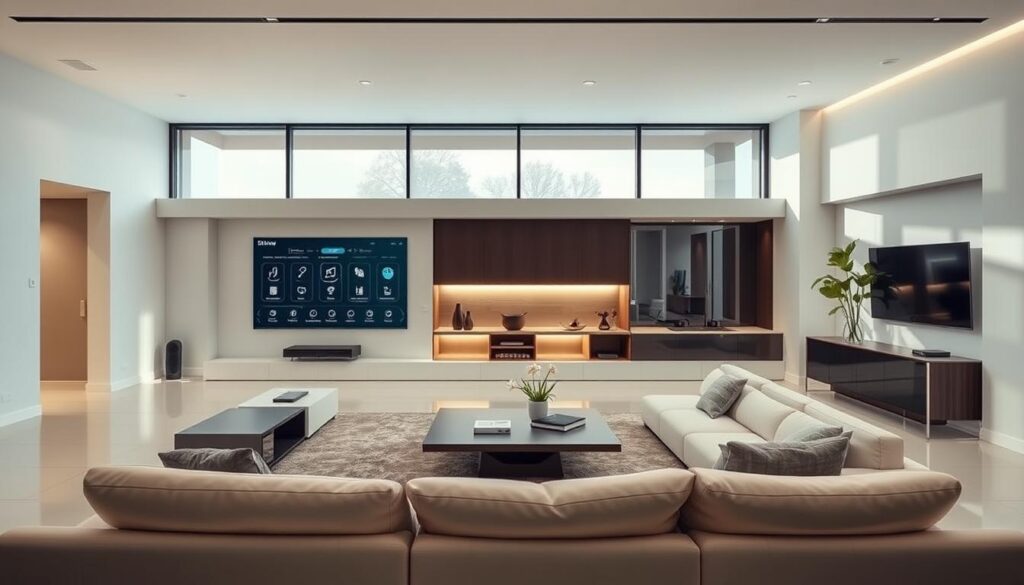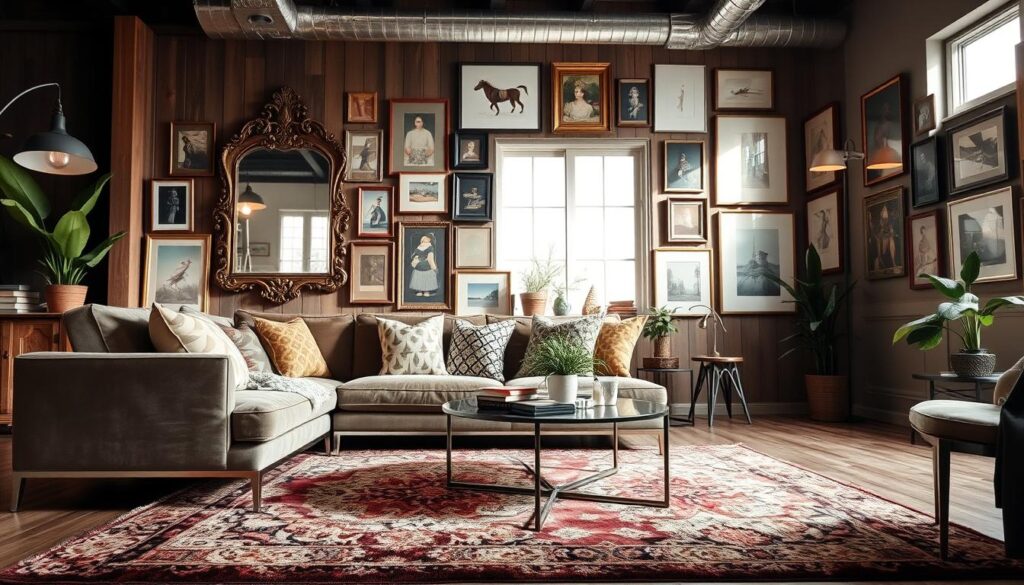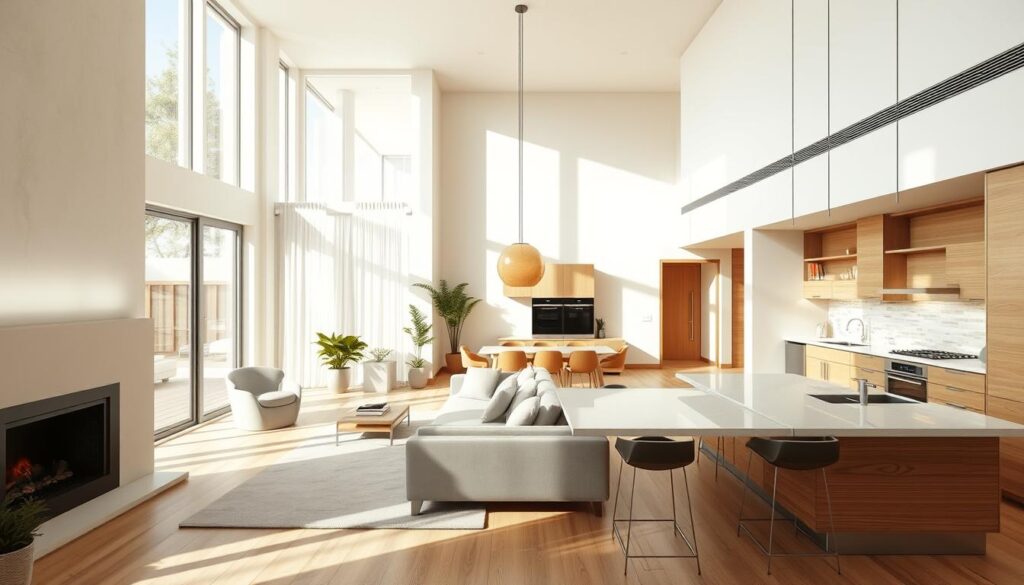As we enter 2023, contemporary home design trends are moving towards being more eco-friendly and tech-savvy.
Many homeowners now focus on eco-friendly decor for their living spaces. This change is seen in the latest interior design trends. They highlight the need for sustainability and personal style.
We’ll look at the top trends for 2023. From eco-friendly design choices to adding personal touches, we’ll cover it all.
Key Takeaways
- Sustainable design choices are becoming increasingly popular.
- High-performance materials are in high demand.
- Saturated wall colors are trending, specially in bathrooms.
- Natural stone slabs are dominating backsplashes and other design elements.
- Muted, warm, and cozy colors are trending.
Embracing Sustainable Design Choices
Our homes are showing our commitment to the environment. We’re choosing designs that are both stylish and green. This change is part of our journey towards a sustainable future.
Choosing the right materials and products is key in sustainable design.
Eco-Friendly Materials
Using eco-friendly materials is essential for a green home. Reclaimed wood, bamboo, and low-VOC paints are great choices. They’re good for the planet and add a special touch to your home.
These materials are now a big part of latest home decor trends. They show our move towards living more sustainably.
Recycled and Upcycled Décor
Recycling and upcycling old items is another smart way to design sustainably. It gives old furniture or decor a new life. This approach is creative and eco-friendly, fitting into popular interior design styles.
Energy-Efficient Appliances
Buying energy-efficient appliances is a smart choice for a greener home. They use less energy and save money on bills. Choosing these appliances is a simple way to help the environment.
Bold Colors and Patterns
Bold colors and patterns are changing home interior design this year. We’re adding more statement pieces to our homes. This shift makes our spaces more interesting.
Using bold colors and patterns does more than just look good. It sets the mood and atmosphere in our homes. The right mix can make any room feel welcoming and show off our style.
Statement Walls
One easy way to add bold colors is with statement walls. A bold wall color can draw attention and add character. Pick a color that fits with home interior design trends and your style.
For a softer look, choose a bold shade that’s just a tone deeper than your usual colors. This keeps the room balanced while still making a bold statement.
Colorful Furniture
Colorful furniture is another great way to bring bold colors into your home. You can find everything from bright sofas to bold chairs. Make sure the furniture you choose fits with trending home accessories for a unified look.
It’s important to balance bold furniture with neutral pieces. This prevents the room from feeling too busy.
Mixing Patterns
Mixing patterns can add a lot of interest to your home. Combining different patterns, like stripes with florals, can make your space unique. The trick is to find a common color to link them all together.
Done right, mixing patterns can take your home décor to the next level. It makes your space more lively and in line with home interior design trends.
Minimalist Aesthetics
Minimalism is a timeless choice in interior design. It focuses on clean lines and uncluttered spaces. This design is not just about looks; it’s about creating a functional and peaceful home.
We will look at what makes minimalist aesthetics special. We’ll see how to find a balance between looks and function.
Functional Furniture
At the core of minimalist design is furniture that is both useful and simple. For example, a sleek sofa can be both a statement piece and a cozy spot to sit. When picking furniture, look for pieces that are functional and simple.
Decluttering Spaces
Getting rid of things we don’t need is key to minimalist design. This makes our spaces calm and clear. Begin by sorting your things and keep only what brings you joy or is useful.
This not only makes your space simpler but also keeps it clutter-free.
Neutral Color Palettes
Neutral colors like white, beige, and gray are central to minimalist design. They create a soothing and unified look. These colors also let you add color with art or accessories easily.
Using neutral colors helps keep your home calm and consistent.
| Design Element | Minimalist Approach | Benefits |
|---|---|---|
| Furniture | Simple, functional pieces | Reduces clutter, enhances functionality |
| Color Palette | Neutral tones | Creates a calming atmosphere, versatile |
| Space Planning | Decluttered, open spaces | Promotes serenity, simplifies maintenance |
By using these minimalist elements, we can make homes that are both beautiful and practical. As we look at modern home design trends, minimalism is still a top choice. It offers a clean and peaceful living space.
Multifunctional Spaces
Remote work and changing lifestyles make multifunctional spaces key. We need homes that are both comfortable and productive. It’s important to make different areas serve multiple purposes without losing style or function.
Home Offices
Setting up a home office is more than just a desk. It’s about creating a space that boosts productivity while matching your home’s decor. Adding trending home accessories like ergonomic furniture and smart storage can really help.
Here are some tips:
- Choose multifunctional furniture, like a storage ottoman or a desk with shelves.
- Use a color scheme that helps you focus and stay calm, following latest home decor trends.
- Ensure good lighting, both natural and artificial, to keep the space inviting all day.
Guest Rooms with Purpose
Guest rooms are now more than just for visitors. They can also be home offices, gyms, or hobby areas. Think about what you need the room to do beyond hosting guests.
A good guest room might have:
- A comfy workspace or reading nook for when guests aren’t there.
- Storage for guests’ things, keeping the room neat and welcoming.
- Technology like smart TVs or wireless charging for a better guest experience.
Open Floor Plans
Open floor plans are popular for their sense of space and family interaction. To make the most of them, define different areas within the space.
Use:
- Rugs and lighting to mark off zones, like a living area or dining space.
- Furniture arrangement to create paths and separate areas without walls.
- Decor that adds interest and personality, showing off latest home decor trends.
Let’s look at how different layouts can optimize multifunctional spaces:
| Layout Strategy | Benefits | Challenges |
|---|---|---|
| Open Floor Plan | Increases sense of space, promotes interaction | Can be noisy, lacks privacy |
| Defined Zones | Clarifies space use, boosts functionality | May feel segmented, needs careful planning |
| Multipurpose Furniture | Increases functionality, saves space | Can be pricey, may need frequent rearrangement |
Biophilic Design: Bringing the Outdoors In
Biophilic design is changing how we see our homes by mixing the outdoors with the indoors. It’s all about reconnecting with nature and improving our health by adding natural elements to our homes.
By using biophilic design, we can make our homes feel more welcoming and healthy. Let’s look at some key elements that make it so effective.
Indoor Plants
Indoor plants are a simple yet effective way to bring nature indoors. They not only clean the air but also add greenery to our homes. Some popular options include:
- Snake plants, known for their low maintenance
- Peace lilies, which are great for air purification
- Spider plants, easy to care for and propagate
Natural Light Integration
Maximizing natural light is key in biophilic design. It helps us use less artificial light and makes our homes feel more welcoming. Some strategies include:
- Using mirrors to reflect natural light into darker areas
- Installing skylights or larger windows to let in more sunlight
- Keeping windows unobstructed to allow sunlight to filter through
By using natural light, we can make our homes feel more inviting and improve our mood.
Water Features
Water features, like fountains or aquariums, add a calming element to our homes. The sound of running water can be very soothing, creating a peaceful space.
When adding water features, think about the space you have and how much upkeep you’re ready for. From small tabletop fountains to big pond installations, there’s a water feature for every home.
In conclusion, biophilic design is a powerful way to improve our homes by bringing the outdoors in. By adding indoor plants, using natural light, and including water features, we can make homes that are not just beautiful but also good for our health.
Smart Home Technology Integration
Smart home technology is now a key part of modern homes. It makes our homes look better and work better too. This is thanks to new tech that we add to our living spaces.
Smart home tech makes our lives easier and more fun. It uses smart devices that we can control from anywhere. These devices can also work on their own, based on what we like.
Smart Lighting Solutions
Smart lighting lets us change the feel of our homes easily. We can pick the brightness and color of the lights. This changes how a room feels and works.
- Energy efficiency through automated lighting schedules
- Enhanced security with remote access
- Customizable lighting scenes for different occasions
Automated Climate Control
Automated climate control keeps our homes just right. It saves energy and cuts down on bills.
Some benefits include:
- Learning your temperature preferences over time
- Geofencing capabilities to adjust temperature based on your location
- Detailed energy usage reports
Voice-Activated Assistants
Voice-activated assistants are key in smart homes. They let us control our devices easily with just our voice.
Key features include:
| Feature | Description | Benefit |
|---|---|---|
| Voice Control | Control devices with voice commands | Hands-free operation |
| Smart Home Integration | Integrates with various smart devices | Unified control system |
| Information Services | Provides news, weather, and more | Stay informed effortlessly |
Adding these smart technologies to our homes makes life better. It also helps us live more sustainably and efficiently.

Vintage and Retro Inspirations
The trend of vintage and retro is big in 2023 home decor. Homeowners want to add unique touches to their spaces. They’re turning to past decades for inspiration.
Furniture Revivals
Updating old furniture is a great way to bring vintage charm into your home. You can use new materials or reupholster old pieces. For example, a vintage armchair can get a new look with modern fabric.
Key pieces to consider:
- Mid-century modern sofas
- Victorian-era armchairs
- Retro-patterned dining chairs
Antique Accents
Adding antique items can make your home feel richer and more historical. You can use old vases, decorative objects, or lights. But, mix these with modern items to keep the space balanced.
Tips for incorporating antique accents:
- Start with a single statement piece, like a vintage chandelier.
- Mix antique items with contemporary decor to create a curated look.
- Consider the era and style of your antique pieces to ensure they complement your overall design.
Nostalgic Color Schemes
Using nostalgic colors can also bring a vintage vibe to your home. Think of the bold 1970s or the soft 1950s. These colors can brighten walls, furniture, and accessories.
Popular nostalgic color schemes include:
- Retro brights: Think bold oranges, yellows, and reds.
- Pastel palettes: Soft pinks, blues, and mint greens evoke a nostalgic feel.
- Earth tones: Warm beiges, browns, and tans reminiscent of the 1970s.
By embracing vintage and retro, homes become stylish and full of history. Whether through furniture updates, antique pieces, or classic colors, there’s a lot to explore. It’s a great way to make your modern home stand out.
Textural Variety in Interior Spaces
Mixing textures can add character and personality to your home. It creates a rich, inviting atmosphere that shows off your style.
Mixing Fabrics and Materials
Combining different fabrics and materials adds depth to your space. For example, smooth leather with chunky woven baskets or velvet with linen creates an interesting contrast. This mix makes your space feel dynamic and layered.
Think about the feel and how they catch light. Smooth surfaces like silk or satin reflect light, while rougher textures like wool or jute absorb it. This creates a cozy feel.
Layering Rugs
Layering rugs adds texture to your rooms. A smaller, textured rug on top of a larger, neutral one creates a focal point. It adds warmth and visual interest, helping to define areas in open-plan spaces.
Accent Textiles
Accent textiles like throw pillows, blankets, and wall hangings introduce new textures easily. They can be changed seasonally or with trends, making them versatile in design.
Here’s a comparison of different textures and their effects on a room’s ambiance:
| Texture | Effect on Ambiance | Best Used In |
|---|---|---|
| Smooth Leather | Modern, sleek | Living rooms, offices |
| Woven Baskets | Cozy, natural | Bedrooms, family rooms |
| Velvet | Luxurious, sophisticated | Dining rooms, formal living areas |

By mixing textures thoughtfully, you can make your home look better and feel welcoming. It shows off your personal style.
Personal Touches in Design
Personal touches make a house feel like home. Adding elements that show your personality and story is key. This makes your space feel real and welcoming.
Adding Unique Flair
Custom artwork is a great way to add a personal touch. It reflects the latest home design trends. By choosing pieces that speak to you, you can create a unique and captivating atmosphere.
Incorporating Family Heritage
Family heirlooms add warmth and character to your home. They align with the latest home decor trends. By integrating these pieces into your design, you can tell your story through your space.
Travel-Inspired Elements
Travel-inspired décor adds a fascinating layer to your space. It reflects your experiences and adventures. By adding these elements, you can make your home truly personal and reflective of your style.


